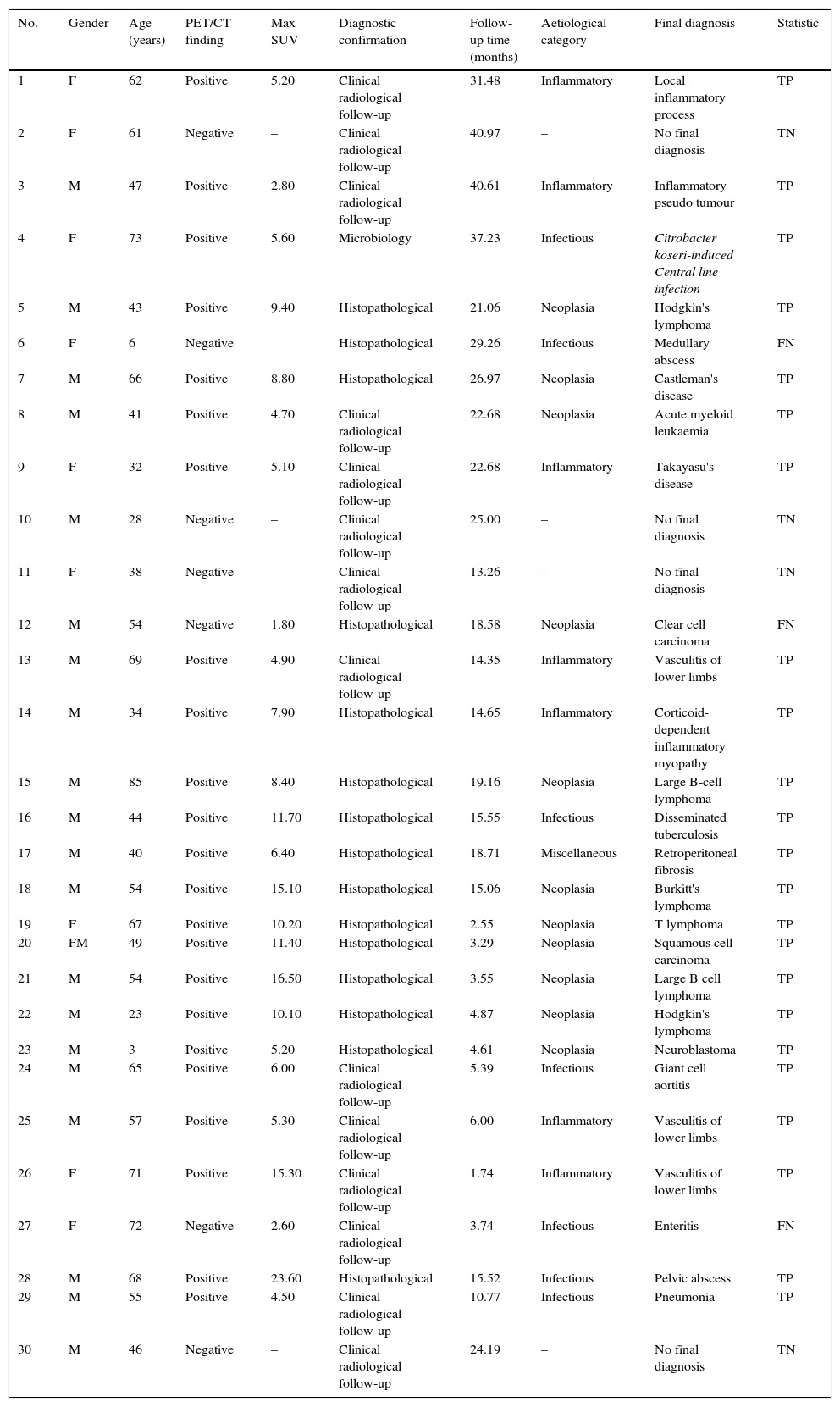Classic fever of unknown origin (FUO) is defined as the presence of fever greater than 38.3°C of at least 3 weeks with an uncertain diagnosis. Identification of the aetiology is crucial in guiding further diagnostic procedures and subsequent patient management. The aim of this study was to evaluate the role of fluorine-18 fluorodeoxyglucose (18F-FDG) positron emission tomography combined with computed tomography (PET/CT) in the diagnostic orientation of FUO.
Material and methodAn observational retrospective study was performed, including 30 consecutive patients who had been studied between March 2010 and September 2013. Twenty-six out of 30 patients (86.67%) had a definitive diagnosis after pathologic confirmation in 15 cases, microbiological findings in one patient and clinical and radiological follow-up in 10 patients (mean: 16.38 months).
ResultsAmong the positive scans, malignancy (n=10), inflammatory (n=8), infectious (n=4) and miscellaneous causes (n=1) were identified. 18F-FDG PET/CT had a diagnostic accuracy of 90.00%, sensitivity of 88.46% (95% confidence interval [95% CI] 76–101), specificity of 100.00% (95% CI 100–100), positive predictive values of 100.00% (95% CI 100–100) and negative predictive value of 57.14% (95% CI 20–91).
Conclusions18F-FDG PET/CT provided useful for the aetiologic diagnosis of FUO, with high sensitivity and specificity. 18F-FDG PET/CT has an incremental morphological and functional value, especially indicating the best biopsy site.
La fiebre de origen desconocido (FOD) se define clásicamente como fiebre de más de 3 semanas, con temperatura superior a 38,3°C en varias ocasiones y sin diagnóstico definitivo tras una semana de hospitalización. Determinar su etiología es fundamental para establecer un tratamiento adecuado del paciente. Nuestro objetivo es valorar la utilidad de la tomografía por emisión de positrones con 18F-Fluorodesoxiglucosa (18F-FDG) combinada con tomografía computarizada (PET/TC) con fluorodesoxiglucosa marcada con flúor 18 (18F-FDG) en la orientación diagnóstica de la FOD.
Material y métodoEstudio observacional retrospectivo de exploraciones PET/TC realizadas a 30 pacientes consecutivos con FOD entre marzo de 2010 y septiembre de 2013. El diagnóstico definitivo se alcanzó en 26/30 pacientes (86,67%): 15 con confirmación histológica, microbiológica en un caso y con seguimiento clinicorradiológico (media de 16,38 meses) en 10 pacientes.
ResultadosUn total de 23 estudios fueron positivos: 10 con etiología tumoral, 8 inflamatoria, 4 infecciosa y uno miscelánea (100% verdaderos positivos). La PET/TC mostró una eficacia en el enfoque diagnóstico del 90,00%, una sensibilidad del 88,46% (intervalo de confianza del 95% [IC 95%] 76–101), una especificidad del 100,00% (IC 95% 100–100), un valor predictivo positivo del 100,00% (IC 95% 100–100) y un valour predictivo negativo del 57,14% (IC 95% 20–91).
ConclusionesLa 18F-FDG PET/TC ha demostrado presentar una elevada sensibilidad y especificidad en el diagnóstico etiológico de la FOD, aportando una información morfofuncional valiosa, especialmente en la localización del lugar óptimo para la toma de biopsias.








